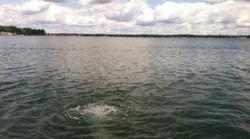
Fort Collins, Colorado (PRWEB) June 11, 2013
Oxygen deprived Colorado lakes and reservoirs are about to get desperately needed help in the fight against nutrient pollution, invasive weeds and seasonal algae growth. Building on scientifically proven results and a cost effective financial strategy, Michigan based Lake Savers LLC is expanding operations to include large fresh water bodies in the state of Colorado.
Weve had tremendous success reversing the trend of eutrophication in large lakes in the Midwest and upper Northeastern United States. The Rocky Mountain region is next. says Dr. William Bledsoe, Director of Communication for Lake Savers LLC. Were the only company equipped to restore dissolved oxygen to large lakes and reservoirs in the United States and we have the scientific data to prove our success.
Why Colorado?
Its personal. I live in Colorado and have been fishing the lakes and rivers since I was kid says Dr. Bledsoe. With the rapid growth in population and development around front range lakes, Ive witnessed a decline in their health. I want to stop that. Colorado lakes and reservoirs are a precious asset. Theres no reason why the success weve had in the Midwest cant happen in Colorado.
A New Approach
To date, the go-to strategy for eradicating seasonal invasive Eurasian Milfoil and algae blooms has been to dump chemical herbicides and algaecides in lakes. While effective in the short-term, Dr. Bledsoe says this symptom treatment strategy doesnt fix whats causing weed and algae growth in the first place lack of dissolved oxygen and lake-bottom muck which fuels weeds and algae.
According to Dr. Bledsoe, herbicides make the problem worse by sending dead weeds and algae to the bottom of the lake, adding to the organic muck, further depleting dissolved oxygen, and perpetuating the cycle of internal nutrient overloading fueling the next weed and algae explosion. We reverse that destructive nutrient overloading cycle by restoring dissolved oxygen to the bottom of the lake, boosting aerobic bacteria and diatomic production. We restore the lake-bottom ecosystem and the lake is brought back into biological balance. Weeds and algae disappear naturally and water quality improves dramatically. Best of all, its sustainable.
Scientific Proof
You cant argue with the scientific data. Independent studies conducted on four Michigan Lakes by Restorative Lake Sciences LLC in 2012 provide irrefutable evidence that Lake Savers all-natural approach quickly and substantially reverses the trend of nutrient overloading.
The studies conducted on Indian Lake, Paradise Lake, Austin Lake, and Keeler Lake were the most comprehensive limnological analyses ever performed of large-scale use of laminar flow Inversion Oxygenation and Biological Augmentation in severely impaired lakes. According to limnologist Jennifer Jermalowicz-Jones, This technology has been a highly effective tool for preventing severe trophic shifts in impaired lakes. In most cases, the benefits have been universal and consistent among sites, providing an increase in dissolved oxygen and water clarity, a decrease in nuisance algal blooms and organic matter, and decreasing sediment and water column nutrient loads.
The studies provided baseline water quality analyses and measured the decrease in sediment phosphorous, nitrogen, excess weed growth and algal blooms, and overall water quality after installation of the chemical-free technology.
On Indian Lake there was a 2 foot reduction in organic sediment (muck), a 35% reduction in Eurasian Watermilfoil, a significant reduction in blue-green algae, and a 2 foot increase in water clarity over two summers. On Austin Lake after only 3 months of operation there was a 63% reduction in Milfoil and a 9 inch reduction in organic sediment. On Keeler Lake there was a 48% reduction in Curly Leaf Pondweed, Milfoil, and a significant reduction in sediment phosphorous after only one year. On Paradise Lake Eurasian Watermilfoil was reduced approximately 40% in only 3 months, and 2012 was the first season with no dense canopy of Milfoil covering the surface of the 400 acre West Bay.
When asked about the remarkable results, Lake Savers President John Tucci explained what were doing is restoring the lakes ability to convert phosphorous and other nutrients into a healthy food-web (fish) and away from weed and algae growth. In essence, were restoring the lakes natural biological mechanism for nutrient reduction.
What About Cost?
In most cases we can restore and sustain a large residential lake or reservoir for substantially less than the cost of chemical herbicide treatments and dredging. We can do this because we design each lake-specific system for free, make the initial capital investment in the technology and equipment, and annualize the cost over time says Tucci. Theres no reason why people cant have a healthy lake immediately.
The challenge is getting lake and reservoir managers and homeowner associations to think proactively and choose sustainability instead of chemicals says Dr. Bledsoe. Though Colorado lakes are unique in terms of climate and geography, the biology of nutrient pollution coming from the watershed is not. And with the looming threat of nutrient overloading presented by the recent fires, we sincerely hope people who love and depend on Colorado lakes and reservoirs make the right choice.
Related Healthy Food Press Releases
No comments:
Post a Comment